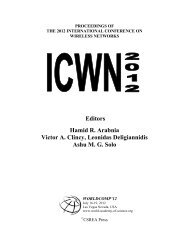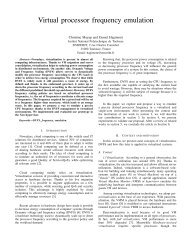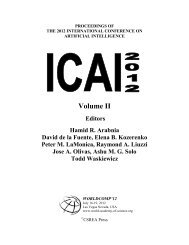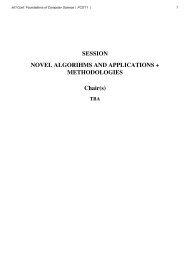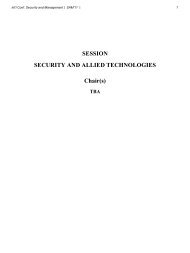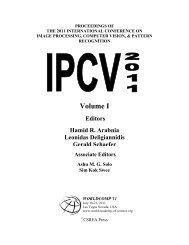SESSION GRAPH BASED AND TREE METHODS + RELATED ...
SESSION GRAPH BASED AND TREE METHODS + RELATED ...
SESSION GRAPH BASED AND TREE METHODS + RELATED ...
- TAGS
- graph
- methods
- world-comp.org
You also want an ePaper? Increase the reach of your titles
YUMPU automatically turns print PDFs into web optimized ePapers that Google loves.
34 Int'l Conf. Foundations of Computer Science | FCS'12 |<br />
The Parameterized Complexity of Perfect Code in Graphs without<br />
Small Cycles<br />
Yong Zhang<br />
Department of Computer Science, Kutztown University of Pennsylvania, Kutztown, PA 19530<br />
Abstract— We study the parameterized complexity of k-<br />
PERFECT CODE in graphs without small cycles. We show<br />
that k-PERFECT CODE is W[1]-hard in bipartite graphs and<br />
thus in graphs with girth 4. On the other hand, we show that<br />
k-PERFECT CODE admits a k 2 + k kernel in graphs with<br />
girth ≥ 5.<br />
Keywords: parameterized complexity, perfect code<br />
1. Introduction<br />
Parameterized complexity is a powerful framework that<br />
deals with hard computational problems. A parameterized<br />
problem is a set of instances of the form (x,k), where x<br />
is the input instance and k is a nonnegative integer called<br />
the parameter. A parameterized problem is said to be fixed<br />
parameter tractable if there is an algorithm that solves<br />
the problem in time f(k)|x| O(1) , where f is a computable<br />
function solely dependent on k, and |x| is the size of the<br />
input instance. The kernelization of a parameterized problem<br />
is a reduction to a problem kernel, that is, to apply a<br />
polynomial-time algorithm to transform any input instance<br />
(x,k) to an equivalent reduced instance (x ′ ,k ′ ) with k ′ ≤ k<br />
and |x ′ | ≤ g(k) for some function g solely dependent on<br />
k . A parameterized problem is fixed parameter tractable<br />
if and only if it is kernelizable. On the other hand, many<br />
fixed parameter intractable problems can be classified in<br />
a hierarchy of complexity classes W[1] ⊆ W[2] ... ⊆<br />
W[t]. For example, k-INDEPENDENT SET and k-CLIQUE<br />
are known to be W[1]-complete and k-DOMINATING SET<br />
is known to be W[2]-complete. We refer the readers to [1],<br />
[2] for more details.<br />
Let G = (V,E) be an undirected graph. For a vertex<br />
v ∈ V , let N(v) and N[v] be the open neighborhood and<br />
closed neighborhood of v, respectively. A perfect code in G<br />
is a subset of vertices D ⊆ V such that for every vertex<br />
v ∈ V , there is exactly one vertex in N[v]∩D.<br />
Definition 1.1: Given an input graph G and a positive<br />
integer k, the k-PERFECT CODE problem is to determine<br />
whether G has a perfect code of size at most k.<br />
In the literatures k-PERFECT CODE is also known as EF-<br />
FICIENT DOMINATING SET, PERFECT DOMINATING SET,<br />
and INDEPENDENT PERFECT DOMINATING SET. It is a<br />
well-known NP-complete problem. Its computational complexity<br />
in various classes of graphs has been extensively<br />
studied. See Lu and Tang [3] for an overview. In terms<br />
of parameterized complexity, k-PERFECT CODE is known<br />
to be W[1]-complete [4], [5] in general graphs. Guo and<br />
Niedermeier [6] showed that k-PERFECT CODE is fixed<br />
parameter tractable in planar graphs by giving a 84k kernel.<br />
Dawar and Kreutzer [7] showed that it is fixed parameter<br />
tractable in effectively nowhere-dense classes of graphs.<br />
The girth of a graph is the length of the shortest cycle<br />
contained in the graph. In this paper we study the parameterized<br />
complexity of k-PERFECT CODE in graphs with<br />
certain girths, i.e., graphs without small cycles. The parameterized<br />
complexity of several related problems, including<br />
k-DOMINATING SET and k-INDEPENDENT SET [8], and k-<br />
CONNECTED DOMINATING SET [9] in graphs without small<br />
cycles has been studied. In this paper we show that k-<br />
PERFECT CODE is W[1]-hard in bipartite graphs, and thus<br />
in triangle-free graphs or graphs with girth 4. Then we show<br />
that k-PERFECT CODE admits a k 2 +k kernel in graphs with<br />
girth ≥ 5 and is therefore fixed parameter tractable.<br />
2. Main results<br />
2.1 Bipartite Graphs<br />
To show the W[1]-hardness of k-PERFECT CODE in<br />
bipartite graphs, we give a reduction from the problem k-<br />
MULTICOLORED CLIQUE: Given a graph G = (V,E) and<br />
a vertex-coloring κ : V → {1,2,...,k}, decide whether<br />
G has a clique of k vertices containing exactly one vertex<br />
of each color. k-MULTICOLORED CLIQUE is shown to be<br />
W[1]-complete by Fellows et al. [10].<br />
Theorem 2.1: k-PERFECT CODE is W[1]-complete in bipartite<br />
graphs.<br />
Proof: Let (G = (V,E),κ) be an input instance of<br />
k-MULTICOLORED CLIQUE. For each color i, 1 ≤ i ≤ k,<br />
let Vi be the set of vertices in G with color i. Let ni be<br />
the number of vertices in Vi. Without loss of generality, we<br />
assume that ni > 1 for all i. We fixed an ordering of the<br />
vertices in each Vi. To simplify the presentation, we abuse<br />
notations here: for two vertices u,v ∈ Vi, u > v means u is<br />
in front of v with respect to the fixed ordering. Without loss<br />
of generality, we also assume that no edge in G connects<br />
two vertices of the same color. For any two colors i and j,<br />
1 ≤ i < j ≤ k, let Eij be the set of edges in G that connect



